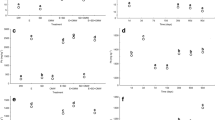Abstract
Sieved agricultural soil samples were treated with the anti-knock agent tetraethyl lead (Et4Pb), and the resulting effects were analyzed by microcalorimetry. Et4Pb additions resulted in an increase of the heat production rate, provided that oxygen was present and that the soil was not autoclaved. The increased heat production rate was accompanied by degradation of Et4Pb, as verified by speciation analysis (GC-MS) of the remaining Et4Pb and its ionic degradation products (triethyl lead and diethyl lead cations). Conclusive evidence was obtained that these transformations were mediated mainly by microbes. At an initial Et4Pb concentration of 2 g Pb/kg dry weight the biodegradation rate was about 780 μmol day−1 kg dry weight−1, whilst the chemical decomposition was only 50 μmol day−1 kg dry weight−1. A fivefold rise of the initial Et4Pb concentration resulted in a decrease of the biodegradation rate to 600 μmol day−1 kg dry weight−1 and an increase of the chemical decomposition to 200 μmol day−1 kg dry weight−1. The biodegradation rate was not influenced by the addition of glucose, which means that no indication for a cometabolic attack of Et4Pb was found.
Similar content being viewed by others
Author information
Authors and Affiliations
Additional information
Received: 25 February 1997 / Received revision: 22 April 1997 / Accepted: 27 April 1997
Rights and permissions
About this article
Cite this article
Teeling, H., Cypionka, H. Microbial degradation of tetraethyl lead in soil monitored by microcalorimetry. Appl Microbiol Biotechnol 48, 275–279 (1997). https://doi.org/10.1007/s002530051050
Issue Date:
DOI: https://doi.org/10.1007/s002530051050




